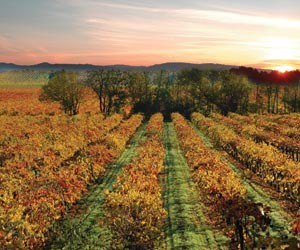Once upon a time, wine country was two beguiling Northern California valleys: Napa and Sonoma. And although the geography has greatly expanded since then, the idea remains just as sanguine—an escape from meeting amidst the hustle and bustle of city life to gather among physical beauty and relaxation.
But the niche has expanded. Planners today can work with wineries, vineyards, restaurants and other suppliers—from Baja California to Maine and Ontario, from Florida to Alaska and Hawaii—and almost anywhere in between.
No matter where they find their wine, however, meeting buyers like their options.
“Going to a winery is the best way to taste the local area and treat attendees to something that makes them feel very appreciated,” says Linda Vernon, CEO of the Bakersfield Association of Realtors. “They serve others all year, so this is their chance to be served.”
Adds Jennifer Ritter, director of sales for Visit Loudon, a Virginia county marketing organization near Washington, D.C., “the consistent message from corporate and association clients is that wine country is a change of pace, an opportunity for peace and focus that gets you away from checking your phone every 30 seconds. We’re only 25 miles from D.C., but that change of scene makes for unforgettable events.”
Wine Country Goes Transcontinental
Planners can find that change of scene across North America.Mexican wineries thrive in Baja California and mainland states from Queretaro north to Sonora. Canadian wineries carpet the Okanagan Valley, east of Vancouver, British Columbia, and hillsides near Lake Ontario, south of Toronto.
Wine country has blossomed in the U.S., too. In 1975, there were just 579 wineries in 34 states, according to WineAmerica, the national wine trade association. Today, 6,700 wineries dot all 50 states. Major meeting cities from Washington, D.C., to San Diego have their local wine country.
In San Francisco, the Mandarin Oriental Hotel pioneered joint programs with Meadowood, a leading Napa Valley resort (see sidebar, page 25) and Fairmont Hotels and Resorts partners with nearby Wine Country producers whenever possible, says regional sales director Michelle Gilman, who covers California and parts of the Southwest.
Winery partners across the Fairmont brand include Okanagan Valley producers in British Columbia; in Toronto, it’s Inniskillin, in Niagara-on-the Lake; in San Francisco, the Benziger Family Winery in Sonoma plays partner; while the Fairmont San Jose works with the iconoclastic Bonny Doon Vineyard in Santa Cruz. Globally, Fairmont features a program with the Napa Valley Vintners and Growers Association.
“Wine country creates experiences and impact like no other kind of event,” Gillman says. “Guests feel like they’re a million miles away [from everday life], even if they’re only 45 minutes out of a major city.
“A lot of groups have become very attached to winemaker dinners or events held in wine caves,” Gillman adds. “To be exposed to such a different world on that personal level is very important.”
Harvest the Variety
What one can experience at a wine country meeting is as varied as wine country itself. More compact destinations such as Napa Valley tend to be groomed and resort-like. Neighboring—and far larger—Sonoma features a greater variety of scenery and price points.
“Wine country can be much more price-conscious than people realize,” says Robin McKee-Cant, CMP, national sales manager of the Sonoma County Tourism Bureau. “We have multiple hotels that carry a major flag, as well as independents who compete vigorously.”
A broader geographic and agricultural base also gives Sonoma more activity choices. In addition to wine tasting and wine blending, planners can include cheese making, bread making, biking, hiking, kayaking and even a zipline adventure through old growth redwood forests on a meeting’s itinerary.
In Virginia, the focus is on the state’s history as the original wine country—17th century settlers in Jamestown were required to plant grapes. Thomas Jefferson, James Madison, George Washington and others maintained European-style vineyards. Today, the state has more than 300 wineries, many of them group-friendly with meeting space.
“We all to want to meet outside the box,” says Carol Torricelli, director of domestic sales at the Virginia Tourism Corporation. Going to a vineyard is a perfect recipe for enhancing any meeting.”
In Williamsburg, the Williamsburg Winery and Wedmore Place can handle groups of up to 180 guests. Statewide, North Gate Vineyard is one of the first LEED Gold-certified wineries in the country. Breaux Vineyards offers secure, gated grounds for product launches and other events that require privacy.
Attendees at Sunset Hills Vineyard create their own wine, from winery name and logo to designing their own blend and label, which the winery creates, bottles and distributes for attendees to take home. Notaviva Vineyards pairs wine and music, right down to providing instruments for an attendee jam session.
Heading North
British Columbia usually lures smaller groups, although Mission Hill Family Estate Winery can handle up to 400 in its Italianate facility and outdoor theater overlooking Kelowna. The nearby Penticton Trade & Convention Centre offers over 60,000 square feet of meeting space, but groups of 100 or fewer are the norm and activities are unique.
Nearly 275 miles of railroad track has been replaced by hiking and biking trails with no slope steeper than a gentle 2.5 degrees. Groups can bike to more than two dozen wineries within 10 miles of Penticton, then bike back or ride in vintage style convertibles. More adventurous attendees can even kayak to a string of lakefront wineries while sedentary types can taste the same wines on a lake cruise aboard the paddlewheel Casabella Princess.
Fred Gebhart has covered the meetings industry for more than 30 years.






